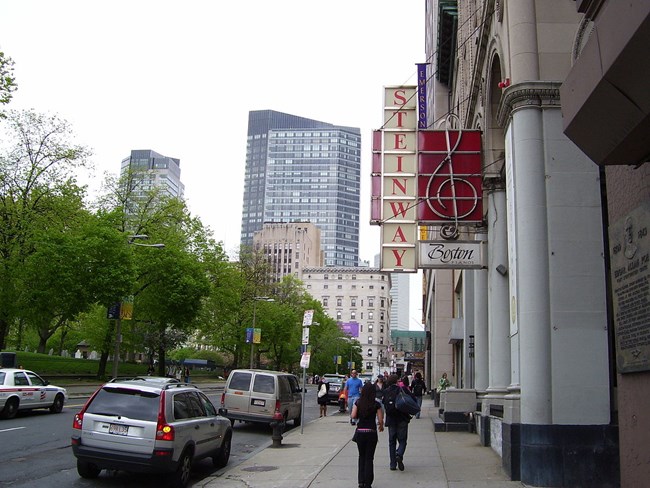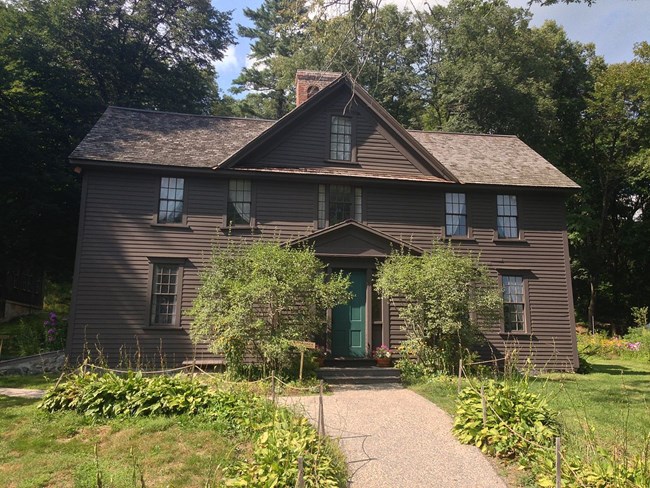Part of a series of articles titled Creative Teaching with Historic Places: Selections from CRM Vol 23 no 8 (2000).
Article
Preparing Teachers to Teach with Historic Places

https://en.wikipedia.org/wiki/File:Piano_Row_District_Boston_MA.jpg
Published by the National Park Service, Cultural Resources
by Charles S. White and Deborah J. D. White
Students in the elementary social studies methods course at Boston University need to be convinced that history ought to be an important part of their teaching. Most confess that history was a deadly bore when they were in school; their experience with university history courses wasn’t much better, so they say. These students are becoming teachers because they love children and they are eager to help children learn how to read and write and to have fun learning. History is not really high on the students’ agenda. Nor do many elementary schools present strong models for these novice teachers; history and social studies are too often relegated to an occasional late afternoon, if there is time. An increasing number of states, however, are raising standards for history and social studies, and tying those standards to state tests. Testing aspiring teachers as a condition for certification also has helped sharpen the focus on history over the past several years. All too often, though, standards and testing are viewed as the stick in the education reform; we are more interested in the carrot.
The carrot is history’s intrinsic attraction, often recognized as one develops a “sense of place” – an empathetic understanding of place as a stage on which the lives of real people and events played out, which creates a powerful bond between students and history. This engagement with “the story” is part of what draws people to history and part of the reason we teach history to children (to “learn from the story”). Less obvious, perhaps, is the recognition that history is a collection of stories constructed from pieces of evidence that the historian uses to interpret the past. Historical inquiry – the process historians use to unravel the mysteries of the past – can engage children as well. The curiosity and connection to the past are the carrots that we hope will coax methods students and experienced teachers alike to teach with historic places.
Historic Places in the Preservice Methods Course
Charles S. White
Teaching the content of history and the nature and skills of historical inquiry are mainstream components of most social studies methods courses and texts. The role of place in teaching history is usually described in the context of “field trips,” but my students have learned that I prefer engaging children in “field studies” – trips to places where historical evidence can be gathered, historical inferences tested, and a sense of place fostered. When I get to the section of the course on methods of inquiry and problem solving, I take my students on a field study.
Some years ago, I was introduced to a historic district in Boston called Piano Row. Its location in the city, near the Boston Common, makes it an ideal setting around which to construct a study of Boston’s changing landscape and patterns of human activity. Starting at the Arlington Street Church, a couple of blocks from Piano Row, we begin by orienting ourselves with the help of a map. My students discover that this 1722 map is missing some information. Even after identifying current landmarks and locating them on this dated map, my students are reluctant to come to the correct conclusion – that where they now stand there was nothing but water in 1722. Suddenly it becomes clear why people call this area the Back Bay. For nearly four years, my students have lived on a university campus in the Back Bay, but only now has it occurred to them that the name has meaning beyond a label. Now I have their attention.
Walking from the church toward the official historic district, we observe the topography and speculate about where we’ll make landfall based on where the land rises; the map confirms our speculation. As we enter the historic district, our focus shifts to a later time and the current buildings along Boylston Street (at this point, I haven’t told them the nature of the district; that information is the puzzle they need to assemble.)
Warning that today’s signage can be a false clue, I ask what evidence students can see that suggests the original purpose of the building. In the ornamentation of the façade, music instruments appear – as if they had been invisible until that moment. Large display windows on the first floor and smaller windows above hint at a commercial retail use. Over the course of this one session, students have deciphered maps, read buildings, compared the widths of streets, discovered the impact of immigration (Chinatown), and explored the role of taverns in the 18th-century, Boston.
By the end of the session, students ask how I discovered this. Most of that information, I tell them, comes from the Piano Row nomination at the National Register of Historic Places. From the nomination, I learned the historical background of the area, as well as patterns of visual clues I coax my students to discover. Young children also can be guided to discover patterns around them that have historical significance. The field study was also a good experience in recognizing the kinds of questions teachers should ask and questions students might raise that can be answered, at least tentatively, when they return to their classroom, using primary and secondary sources.

https://en.wikipedia.org/wiki/File:Orchard_House_from_Little_Women.jpeg
Deborah J. White
An increasing number of states are placing greater emphasis on teaching and learning history across all grade levels. Professional development for experienced teachers helps promote more and better history instruction. Massachusetts is one state that provides grant funding for “content institutes” to deepen inservice teachers’ knowledge of history. As professional development coordinator for the North River Collaborative, which provides professional development services for seven school districts south of Boston, I worked with Charles White to develop and deliver a Teaching with Historic Places (TwHP) institute during the 1999-2000 school year. It proved to be so popular that a second institute, planned for 2000-2001, was over-subscribed even before it was officially announced.
Unlike most one-shot workshops, the TwHP institute spanned six months, from December through May. Through a combination of seminars and field studies, 17 teachers from elementary through junior high school deepened their content knowledge and learned how to integrate historic places into the curriculum in a way that is consistent with the Massachusetts curriculum frameworks.
The typical pattern of the institute involved a Thursday evening seminar followed by an all-day Saturday field study. The purpose of the seminar sessions was twofold: to learn how place could be used to teach history and to prepare specifically for the subsequent field study. For the former, we followed Teaching with Historic Places: A Curriculum Framework for Professional Training and Development of Teachers, Preservationists, and Museum and Site Interpreters. Sessions addressed the range of documents relating to place that can support historical inquiry, skills involved in teaching with place, links to the school curriculum, and strategies for developing and implementing TwHP activities in the classroom. For the latter, we introduced teachers to a variety of primary and secondary sources (maps, letters, literature, and readings from the work of historians) to construct the historical context for the field study and generate questions to be pursued at the site. We selected four varied sites in eastern Massachusetts for the field studies: Piano Row in Boston, the Adams National Historic Site in Quincy, several sites in Lexington and Concord, and the Frederick Law Olmstead National Historic Site in Brookline (as well as two of his parks: the Arnold Arboretum and Franklin Park). We also took the opportunity to weave literature into the institute. Our studies of the Old Manse and Orchard House in Concord, the focal point of the Transcendentalist movement in 19th-century America, provided ideal opportunities to draw on the work of Hawthorne, Thoreau, Emerson, and Bronson Alcott.
Each institute participant developed a history-based instructional unit that integrated the teaching of place into their existing curriculum. We encouraged teachers to explore their local communities’ history and to connect it to the larger trends and movements in US history. They were assisted by the Massachusetts Historical Commission, which hosted a visit by the institute participants. The teachers’ eyes were opened to the extraordinary state and local historical resources preserved by the Commission. Some teachers chose to pursue graduate credit for the institute, offered through Fitchburg State College, for which they each wrote a paper reviewing a work of history related to a site we studies and identifying links to the site and to the state curriculum framework.
Teachers reported a tremendous enthusiasm for the TwHP projects they were doing at the local level. Librarians, members of local historical societies, and community elders were thrilled to discover teachers’ interest in the history of their town, and they opened their considerable treasures to benefit the instructional units. Teachers also came to see the potential of place to serve as an important motivator for students’ study of history as well as teachers’ motivation to teach history in a sustained an engaging way.
Conclusion:
For those committed to preserving historic places in order to pass along our nation’s heritage to future generations, public schools must be drawn in as full partners and participants. That partnership will not be cemented unless preservice and inservice teachers come to recognize that place can be a powerful tool in helping their students meet the demands of curriculum standards and testing. Outreach to teacher training institutions and professional development providers is essential, and constitutes one of the greatest challenges and, we hope, one of the highest priorities for stewards of America’s historic places.
Resources:
Poppeliers, John C., S. Allen Chambers, Jr., and Nancy B. Schwartz. What Style Is It? A Guide to American Architecture. Washington, DC: The Preservation Press, 1983.
Teaching with Historic Places sample lesson plans. National Register of Historic Places, National Park Service.
White, Charles S. and Kathleen A. Hunter. Teaching with Historic Places: A Curriculum Framework for Professional Training and Development of Teachers, Preservations, and Museum and Site Interpreters. Washington, DC: National Trust for Historic Preservation, 1995.
At the time of publication, Charles S. White was Associate Professor, School of Education, Boston University, Boston, Massachusetts; Deboarah J. D. White was Professional Development Coordinator, North River Collective, Rockland, Massachusetts.
Last updated: July 2, 2019
